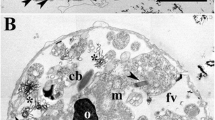Summary
Electron microscopical investigations of 9 species of Closterium revealed that the cell wall in the genus Closterium is composed of an amorphous outer layer, the fibrillous primary wall and the fibrillous secondary wall. The outer layer is smooth or striated in longitudinal direction. The striation is caused by small grooves or ridges. The distance between the striae is in many cases below the limit of the resolving power of the light microscope. Therefore only 2 of 6 species studied, all of which have striated walls, are well known to be striated hitherto. —The secondary wall consists of bands of microfibrils oriented in parallel as it has been described for the Cosmarium type and Penium type. In Cl. lunula there were no bands of microfibrils.
In all of the species of Closterium studied pores are evident. They are of a round, oval or longish form and their distribution is diffuse or in rows. The diameter of the pores was determined to be 25 nm to 95×190 nm.
The construction of the pores differs from the well known of the Cosmarium type. The perforation is only situated in the outer layer whereas the fibrils of the primary wall and secondary wall run through the cone-shaped channel beneath and give it the appearance of a sieve. In the region of the pore channel an interfibrillous cementing substance seems to be lacking. A pore apparatus is absent, too. Cl. lunula has differently shaped pores.
The observations were compared with the partly contrary declarations in the literature. The significance of the results is discussed with regard to taxonomic questions.
Zusammenfassung
Nach elektronenmikroskopischen Beobachtungen an 9 verschiedenen Closterium-Arten setzt sich die Zellwand der Closterien aus einer amorphen Außenschicht und der fibrillären Primär- und Sekundärwand zusammen. Die Außenschicht ist glatt oder längs gestreift. Die Streifung wird durch ausgesparte Rillen oder aufgelagerte Leisten verursacht. Der Streifenabstand liegt teilweise jenseits des Auflösungsvermögens eines Lichtmikroskopes, so daß von 6 gestreiften Arten bisher nur 2 als gestreift bekannt waren. — Die Sekundärwand besteht, wie die der Vertreter des Cosmarium- und Penium-Typs aus Bändern parallel gelagerter Mikrofibrillen. Cl. lunula zeigt keine Fibrillenbänder.
Bei allen untersuchten Closterien sind Poren in der Zellwand nachzuweisen. Sie sind rund, oval oder länglich, zerstreut oder in Reihen angeordnet. Die Porenweiten liegen zwischen 25 nm und 95×190 nm.
Der Aufbau der Poren weicht von dem bisher bekannten des Cosmarium-Typs ab. Der Porus befindet sich nur in der Außenschicht, während der darunterliegende, kegelförmig gestaltete Porenkanal von den Fibrillen der Primär- und Sekundärwand siebartig durchzogen wird. Eine interfibrilläre Kittsubstanz scheint im Bereich des Porenkanals zu fehlen. Ein Porenapparat ist nicht vorhanden. Cl. lunula besitzt anders gestaltete Poren.
Die Beobachtungen werden mit den sich widersprechenden Literaturangaben verglichen. Auf die Bedeutung der Ergebnisse für taxonomische Fragen wird hingewiesen.
Similar content being viewed by others
Literatur
Chardard, R.: Nouvelles observations sur l'infrastructure de deux Algues Desmidiales: Cosmarium lundellii et Closterium acerosum. Rev. Cytol. Biol. végét. 28, 15–30 (1965).
—: Aspects infrastructuraux de l'autoantagonisme chez deux Desmidiales (Algues Zygophycées). Rev. Cytol. Biol. végét. 29, 335–356 (1966).
—, et C. Rouiller: L'ultrastructure de trois Algues Desmidiées. Etude au microscope électronique. Rev. Cytol. Biol. végét. 18, 153–178 (1957).
Drawert, H., u. I. Metzner-Küster: Licht- und elektronenmikroskopische Untersuchungen an Desmidiaceen. I. Zellwand- und Gallertstrukturen bei einigen Arten. Planta (Berl.) 56, 213–228 (1961).
—, u. M. Mix: II. Hüllgallerte und Schleimbildung bei Micrasterias, Pleurotaenium und Hyalotheca. Planta (Berl.) 56, 237–261 (1961).
Fridvalszky, L., A. Kovács u. Z. Nemes: Mikrokinematographische und elektronenmikroskopische Untersuchungen an Closterium acerosum (Schrank) Ehr. Ann. Univ. Scient. Budapest., Sect. Biol., 8, 87–95 (1966).
Hauptfleisch, P.: Zellmembran und Hüllgallerte der Desmidiaceen. Mitt. Naturwiss. Ver. Neuvorpom. u. Rügen 20, 1–78 (1888).
Krieger, W.: Die Desmidiaceen Europas mit Berücksichtigung der außereuropäischen Arten. In: Rabenhorsts Kryptogamenflora 13, I. Abt., Teil 1. Leipzig: Akad. Verlagsges. 1937.
Lhotský, O.: The pore-systems of the Desmidiaceae. Experientia (Basel) 5, 158 to 159 (1949).
—: The cell-wall structure in Closterium moniliferum (Bory) Ehrb. Věstnik Královské české společn. nauk. Třída mat.-přírod. 12, 1–26 (1951).
Lütkemüller, J.: Die Poren der Desmidiaceengattung Closterium Nitzsch. Öst. bot. Z. 44, 11–16, 49–53 (1894).
—: Die Zellmembran der Desmidiaceen. Cohns Beitr. Biol. Pflanzen 8, 347–414 (1902).
—: Die Zellmembran und die Zellteilung von Closterium Nitzsch. Kritische Bemerkungen. Ber dtsch. bot. Ges. 35, 311–318 (1917).
Mix, M.: Licht- und elektronenmikroskopische Untersuchungen an Desmidiaceen. XII. Zur Feinstruktur der Zellwände und Mikrofibrillen einiger Desmidiaceen vom Cosmarium-Typ. Arch. Mikrobiol. 55, 116–133 (1966).
—: Zur Feinstruktur der Zellwände in der Gattung Penium (Desmidiaceae). Ber. dtsch. bot. Ges. 80, 715–721 (1967).
Wisselingh, C. van: Über die Zellwand von Closterium. Z. Bot. 4, 337–389 (1912).
Wohlfarth-Bottermann, K. E.: Die Kontrastierung tierischer Zellen und Gewebe im Rahmen ihrer elektronenmikroskopischen Untersuchung an ultradünnen Schnitten. Naturwissenschaften 44, 287–288 (1957).
Author information
Authors and Affiliations
Rights and permissions
About this article
Cite this article
Mix, M. Zur Feinstruktur der Zellwände in der Gattung Closterium (Desmidiaceae) unter besonderer Berücksichtigung des Porensystems. Arch. Mikrobiol. 68, 306–325 (1969). https://doi.org/10.1007/BF00408857
Received:
Issue Date:
DOI: https://doi.org/10.1007/BF00408857




